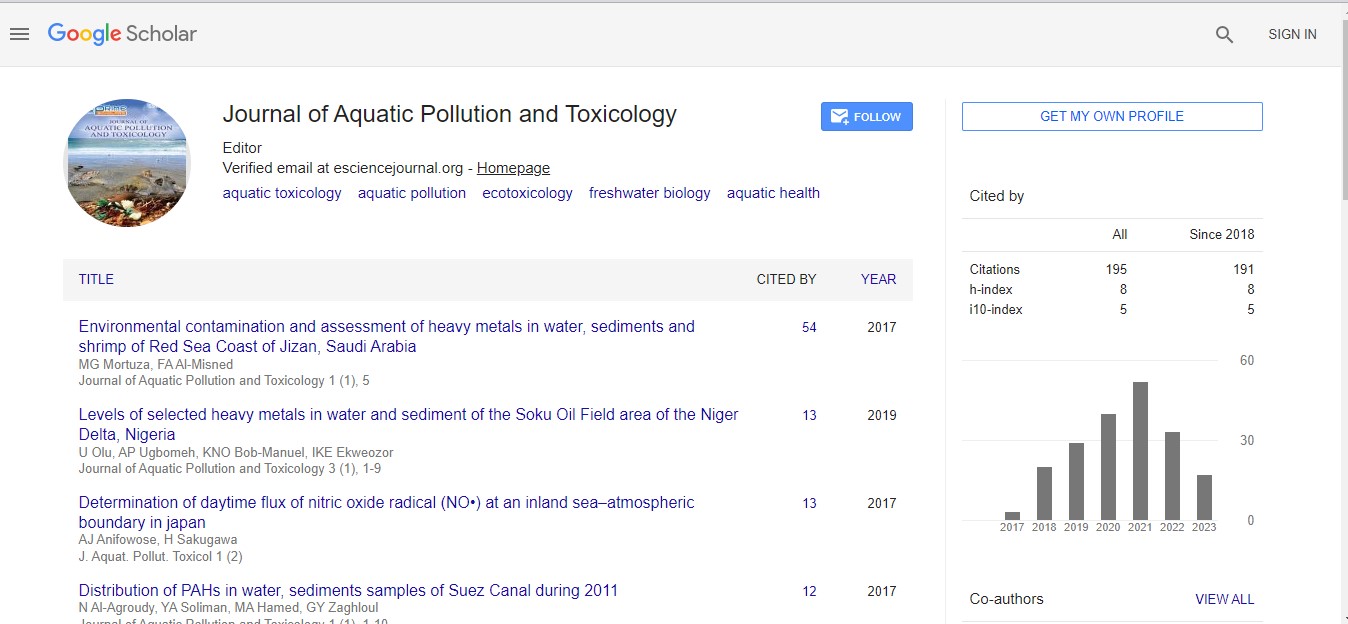General Overview
Journal of Aquatic Pollution and Toxicology is an international
prominent journal which published articles globally in the prime
field of Aquatic Pollution and Toxicology to the forefront of
conceptual developments in the discipline. It is an open access
and peer reviewed journal by eminent Editorial Board and the
manuscripts are peer-reviewed by potential reviewers according
to their research interest.
Journal of Aquatic Pollution and Toxicology offers easy to submit
and review systems. We are using Editor Tracking system for this
purpose. Where Author/Reviewer & Editor can monitor every step
of the article processing through this system, from submission to
publication. This convenient online manuscript submission and
processing system is widely praised by authors for ease of use.
In order to serve the purpose we do classify the research work
in to the following types: Research, Review, Short Review, Case
Report, Case Studies, Case Series, Case Blog, Commentaries,
Short Commentaries, Hypothesis, Thesis etc.,
We would look forward to expand and welcomes a wide range of
members to the Editorial Board who are expert in their respective
discipline and collectively cover the scope of the Journal. We trust
this new editorial structure will ensure their provision in future.
Scope and Focus
Aim
The scope includes study and recent advancements of research
developments and technologies for better and rapid development
in fields of Industrial waste, Mining activities, Sewage and waste
water, Marine dumping, Burning of fossil fuels, Accidental
Oil leakage, Global warming, Atmospheric deposition, Urban
development etc.
Scope
Aquatic Toxicology: Aquatic Toxicology is a multidisciplinary
branch which includes study of natural and synthetic toxicants
and their effects that are leading to toxicity of aquatic systems.
It is a field of Science that focus on study of various chemical
and physical toxins that effect biological living organisms.
Source of aquatic toxicology may also include persistent toxins
such as PCBs, DDT, TBT, pesticides, furans, dioxins, phenols and
radioactive waste, by direct discharges via industrial and urban
effluents, surface run off and indirectly from aerial fallout.
Aquatic Pollution of Aquatic systems (Examples: lakes, rivers,
oceans, aquifers and groundwater) by large amounts of waste
material that modify the water in negative fashion is termed
as Aquatic Pollution. This type of ecological deprivation occurs
when harmful pollutants are directly or indirectly discharged into
aquatic systems without removal of harmful compounds. Aquatic
pollution directly leads to suffering of organisms and vegetation
that survive in water, including amphibians. The main source
of Aquatic pollution include Industrial waste, Mining activities,
Sewage and waste water, Marine dumping, Burning of fossil fuels,
Accidental Oil leakage, Global warming, Atmospheric deposition,
Urban development etc.
Pollution and Toxicology is the science of poisons, which are
sometimes referred to as toxins or toxicants. The earlier term
applies to all natural poisons produced by organisms, such as the
botulin toxin produced by the bacteria Clostridium botulin. Heavy
metals are metallic chemical elements that have a relatively
high density and are toxic or poisonous at low concentrations.
Examples are mercury, lead, nickel, arsenic and cadmium. Such
toxins can accumulate in the tissues of many species of aquatic
life in a process called bioaccumulation.
Focus
We would like to associate with Scientists/ Researchers /
Healthcare companies in publishing each and every advancements
going on in the field of quality improvement and improve our
readership to larger extinct than that of 2019.
Statistical Analytics
During the year 2019, all the issues were published online within
the time and also included editorial conferences in the issues.
Issue released on a bimonthly basis have more than 9000+ Page
views from different diversions such as Asia, Europe and America,
and observed that the visitors have accessed the journal pages
for reading and deriving information for their use.
Critical Role of Digital Marketing
iMedpub is an open access publication networks available in
the world that handles social network sites such as LinkedIn,
Instagram, Facebook, Live Chat, Twitter to promote the articles
published by our journals in order to introduce new trending
information about the recent research works and freely accessed
by means of Open Access Policy.
Journal of Aquatic Pollution and Toxicology specializes in digital
advertising to help clients inform and attract new customers
quickly and efficiently. The size and diversity of our advertising
options, including banners, sponsored emails, article alerts
or newsletters, provide clients with the very best customized
marketing opportunities in science and medicine.
Acknowledgements
Finally I would like to express the gratitude to all the authors,
reviewers, the publisher and the editorial board of the journal
for their support. Especially I would also like to appreciate the
reviewers and the editors warm work earnestly, who are serving
us continuously since day one and brought an invaluable depth
of knowledge, experience and commitment to the journal during
this time. Their work has not only enhanced the reputation of
the journal, but consolidated its presence in emerging research
areas.

